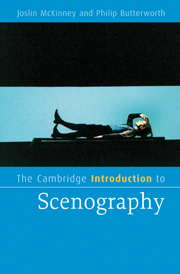Book contents
- Frontmatter
- Contents
- List of illustrations
- List of boxed quotations
- Preface
- Acknowledgements
- Part 1 Elements
- Part 2 Processes of scenography
- Part 3 Realisation and reception
- Chapter 6 Analysis of scenography
- Chapter 7 Reception of scenography
- Chapter 8 Completion and exchange of the image
- Notes
- Bibliography
- Index
- Cambridge Introductions to …
Chapter 6 - Analysis of scenography
Published online by Cambridge University Press: 05 February 2015
- Frontmatter
- Contents
- List of illustrations
- List of boxed quotations
- Preface
- Acknowledgements
- Part 1 Elements
- Part 2 Processes of scenography
- Part 3 Realisation and reception
- Chapter 6 Analysis of scenography
- Chapter 7 Reception of scenography
- Chapter 8 Completion and exchange of the image
- Notes
- Bibliography
- Index
- Cambridge Introductions to …
Summary
So far, this book has focused on the creation of scenography and key issues of its production. This has necessarily involved consideration of scenographic practitioners and the role of scenography in relation to processes of performance and their realisation in production. The following chapters consider ways in which scenography might be discussed from critical and academic viewpoints as central components to the experience of viewing or witnessing performance.
It is important to identify relevant approaches to the analysis of theatre performance in order to determine how they might assist specifically in the analysis of scenography. The dominant influence in this respect has been ‘semiotics’ and theories of the ‘sign’ as means of communication. Although there have been objections to the structuralist nature of semiotics and several post-structural and post-semiotic departures, semiotics has had a widespread influence on the way the performance event is conceptualised and analysed. Bearing this in mind, it is important to examine concepts and approaches which have had particular impact on the way scenography can be considered as an object of study. Elaine Aston and George Savona state that the ‘visual dimension of theatre is in general accorded a somewhat surprisingly low priority in critical and theoretical discussion’. Their work on ‘reading’ the stage image goes some way towards addressing this concern by providing a semiotic account of the creation and analysis of scenography. Their work will be considered in further detail at a later stage.
- Type
- Chapter
- Information
- The Cambridge Introduction to Scenography , pp. 151 - 170Publisher: Cambridge University PressPrint publication year: 2009

